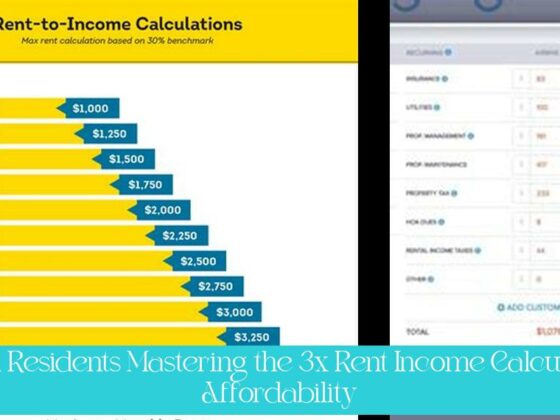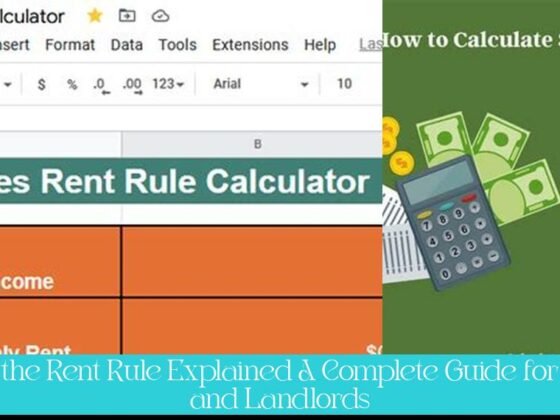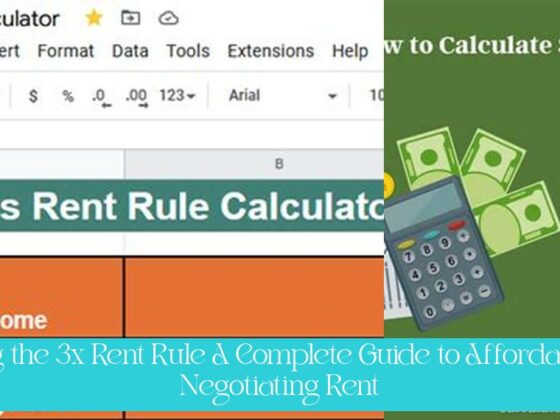Are you ready to dive into the world of renting and the infamous 2.5 times monthly rent rule? Whether you’re a seasoned renter or just dipping your toes into the rental market, understanding this crucial metric can make all the difference in securing your dream apartment. So, buckle up and get ready to uncover the secrets of meeting the 2.5 times monthly rent requirement and exploring alternative paths to rental success. Let’s demystify the 2.5 times monthly rent rule and pave the way for your smooth sailing in the rental landscape.
Key Takeaways
- The 2.5 times rent rule means that a tenant should be earning at least 2.5 times their monthly rent in gross income.
- Some communities use a 3 times rent calculator formula, requiring a renter’s monthly income to be at least 3 times the rent.
- To meet the 2.5x or 3x rent requirement, options include increasing the security deposit, finding a guarantor, or demonstrating financial responsibility.
- For rental approval, places usually require tenants to make 2 or even 3 times the amount of rent, based on their income.
- Landlords may use a rent to income ratio to determine tenant eligibility, such as requiring a tenant to make at least 2.5 times the monthly rent.
- Apartment communities often look for an annual income that is 40 times the monthly rent to determine affordability.
The 2.5 Times Monthly Rent Rule: What It Means and How to Meet It

Understanding the 2.5 Times Rent Rule
In the competitive rental market, landlords often use the 2.5 times rent rule to assess a prospective tenant’s financial stability. This rule states that a tenant’s gross monthly income should be at least 2.5 times the monthly rent amount. For instance, if the rent is $1,200 per month, the tenant’s monthly income should be at least $3,000. This rule helps landlords determine a tenant’s ability to afford the rent and minimize the risk of late or missed payments.
Why Landlords Use the 2.5 Times Rent Rule
Landlords rely on the 2.5 times rent rule for several reasons. Firstly, it provides a quick and straightforward way to evaluate a tenant’s financial situation. By comparing the tenant’s income to the rent amount, landlords can quickly determine if the tenant has sufficient income to cover the rental expenses. Secondly, this rule helps landlords avoid tenants who may struggle to make rent payments on time. Tenants with higher incomes are generally considered lower risk, as they have more financial flexibility to cover unexpected expenses.
How to Meet the 2.5 Times Rent Requirement
Meeting the 2.5 times rent requirement can be challenging, especially in expensive rental markets. Here are some strategies to increase your chances of qualifying:
-
Increase Your Income: The most direct way to meet the requirement is to increase your monthly income. Consider negotiating a raise at your current job, taking on a side hustle, or finding a higher-paying job.
-
Offer a Larger Security Deposit: Some landlords may be willing to accept a larger security deposit in lieu of a higher income. A larger deposit demonstrates your financial stability and willingness to commit to the rental.
-
Find a Guarantor: A guarantor is a person who agrees to be financially responsible for your rent if you default. Having a guarantor with a strong credit score and income can increase your chances of getting approved.
-
Provide Proof of Financial Responsibility: If you don’t meet the 2.5 times rent requirement, you can provide the landlord with bank statements or other financial documents that demonstrate your responsible spending habits and ability to manage your finances.
Alternatives to the 2.5 Times Rent Rule
While the 2.5 times rent rule is common, it’s not the only option for landlords to assess a tenant’s financial eligibility. Some landlords may use a 3 times rent rule, which requires tenants to have a monthly income that is three times the rent amount. Others may use a rent-to-income ratio, which compares the tenant’s monthly rent expense to their monthly income. For example, a landlord may require a tenant’s rent expense to be no more than 30% of their monthly income.
The Importance of a Strong Rental History

In addition to meeting the income requirements, a strong rental history is crucial for getting approved for an apartment. Landlords want to see a consistent pattern of on-time rent payments and responsible behavior. If you have a history of late payments, evictions, or property damage, it may be more difficult to qualify for a rental.
Discover: Unlocking Success: Mastering the 2.5 Times Monthly Rent Rule for Landlords and Tenants
Conclusion
Understanding the 2.5 times rent rule and exploring alternative options can help you navigate the competitive rental market. By meeting the income requirements and demonstrating your financial stability, you can increase your chances of securing a desirable rental property.
1. How do I calculate 2.5 times my rent?
To calculate 2.5 times your rent, simply multiply the monthly rent amount by 2.5. For example, if the monthly rent is $1,000, you should multiply it by 2.5, resulting in a required gross income of $2,500 per month.
2. Is 2.5 times rent enough?
According to the 2.5 times rent rule, a tenant should be earning at least 2.5 times their monthly rent in gross income. While some communities use a 3 times rent calculator formula, it is generally recommended that your income is at least 2.5 times your monthly rent amount to meet the requirement.
3. How to get around 3 times rent?
If a community uses a 3 times rent calculator formula, you may still be able to qualify for the apartment by increasing the security deposit, finding a guarantor, or demonstrating financial responsibility in other ways.
4. Why do landlords use the 2.5 times rent rule?
Landlords use the 2.5 times rent rule to quickly evaluate a tenant’s financial situation and assess their ability to afford the rent. This rule helps landlords minimize the risk of late or missed payments by ensuring that tenants have sufficient income to cover the rental expenses.
5. How can I meet the 2.5 times rent requirement?
To meet the 2.5 times rent requirement, you can increase your income through negotiation or additional work, offer a larger security deposit to demonstrate financial stability, or find a guarantor who can vouch for your ability to cover the rent if needed.
6. What are the key takeaways of the 2.5 times rent rule?
The 2.5 times rent rule means that a tenant should be earning at least 2.5 times their monthly rent in gross income. Some communities may use a 3 times rent calculator formula, but options to meet the 2.5x or 3x rent requirement include increasing the security deposit, finding a guarantor, or demonstrating financial responsibility.










